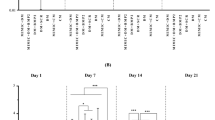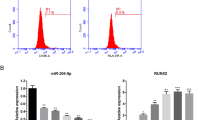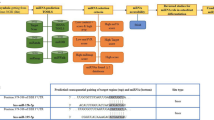Abstract
Elucidation of the molecular mechanisms that regulate the differentiation of adipose-derived mesenchymal stem cells into osteogenic cells may lead to new methods for bone tissue engineering. We examined the role of miR-26a-5p in the regulation of osteogenic differentiation of mouse adipose-derived mesenchymal stem cells (mADSCs) by using mimics and inhibitors of this microRNA. Our results showed that over-expression of miR-26a-5p inhibited osteogenesis and that suppression of endogenous miR-26a-5p promoted osteogenesis. Four bioinformatics algorithms indicated that the 3′UTR of Wnt5a was a potential target of miR-26a-5p. We confirmed this prediction by use of dual-luciferase reporter assay and GFP/RFP assay. We also examined the molecular mechanisms by which miR-26a-5p regulates osteogenesis. Fura-2AM and Western blot assays after transfection indicated that miR-26a-5p repressed WNT5A, inhibited calcium flux and protein kinase C, and suppressed osteogenic differentiation of mADSCs. By contrast, miR-26a-5p inhibition activated these signal proteins and promoted osteogenic differentiation. Taken together, our results suggest that up-regulation of miR-26a-5p inhibits osteogenic differentiation of mADSCs by directly targeting the 3′UTR of Wnt5a, thereby down-regulating the Wnt/Ca2+ signaling pathway.






Similar content being viewed by others
Abbreviations
- ADSCs:
-
Adipose-derived mesenchymal stem cells
- mADSCs:
-
Mouse adipose-derived mesenchymal stem cells
- hADSCs:
-
Human adipose-derived mesenchymal stem cells
- MSCs:
-
Mesenchymal stem cells
- miRNAs:
-
MicroRNAs
- miR-26a:
-
MicroRNA-26a
- miR-NC:
-
MicroRNA-26a-5p negative control
- UTR:
-
Untranslated regions
- CDK6:
-
Cyclin-dependent kinase 6
- HDAC4:
-
Histone deacetylase 4
- USSCs:
-
Unrestricted somatic stem cells
- BMP:
-
Bone morphogenetic protein
- GSK-3β:
-
Glycogen synthase kinase -3β
- PCP:
-
Planar cell polarity
- ROCK:
-
Rho-associated kinase
- PBS:
-
Phosphate buffer saline
- FBS:
-
Fetal calf serum
- qRT-PCR:
-
Quantitative real-time polymerase chain reaction
- GFP:
-
Green fluorescent protein
- RFP:
-
Red fluorescent protein
- MOI:
-
Multiplicity of infection
- WT:
-
Wild type
- Mu:
-
Mutation
- PKC:
-
Protein kinase C
- ALP:
-
Alkaline phosphatase
- OCN:
-
Osteocalcin
- OPN:
-
Osteopontin
- COL1:
-
Collagen type 1
- Runx2:
-
Runt homology domain transcription factor 2
- Osx:
-
Osterix
- CaMKII:
-
Calmodulin-dependent protein kinase II
- GAPDH:
-
Glyceraldehyde-3-phosphate dehydrogenase
- ARS:
-
Alizarin red staining
- D-HBSS:
-
D-Hanks balanced salt solution
- Dsh:
-
Dishevelled
- RhoA:
-
Ras homolog gene family, member A
- JNK:
-
c-Jun N-terminal kinase
- Fz3:
-
Frizzled receptor 3
- Ror2:
-
Receptor tyrosine kinase-like orphan receptor 2
- P-PDLSCs:
-
Periodontal ligament stem cells from chronic periodontitis patients
References
Lu CH, Chang YH, Lin SY, Li KC, Hu YC (2013) Recent progresses in gene delivery-based bone tissue engineering. Biotechnol Adv 31:1695–1706
Sriram M, Sainitya R, Kalyanaraman V, Dhivya S, Selvamurugan N (2015) Biomaterials mediated microRNA delivery for bone tissue engineering. Int J Biol Macromol 74:404–412
Konno M, Hamabe A, Hasegawa S, Ogawa H, Fukusumi T, Nishikawa S, Ohta K, Kano Y, Ozaki M, Noguchi Y, Sakai D, Kudoh T, Kawamoto K, Eguchi H, Satoh T, Tanemura M, Nagano H, Doki Y, Mori M, Ishii H (2013) Adipose-derived mesenchymal stem cells and regenerative medicine. Dev Growth Differ 55:309–318
Peppo GMD, Marolt D (2013) Modulating the biochemical and biophysical culture environment to enhance osteogenic differentiation and maturation of human pluripotent stem cell-derived mesenchymal progenitors. de Peppo Marolt Stem Cell Res Therapy 4:106
Grottkau BE, Lin Y (2013) Osteogenesis of adipose—derived stem cells. Bone Res 2:133–145
Zhang Z, Wang J, Lu X (2014) An integrated study of natural hydroxyapatite-induced osteogenic differentiation of mesenchymal stem cells using transcriptomics, proteomics and microRNA analyses. Biomed Mater 9:045005
Martin EC, Qureshi AT, Dasa V, Freitas MA, Gimble JM, Davis TA (2015) MicroRNA regulation of stem cell differentiation and diseases of the bone and adipose tissue: perspectives on miRNA biogenesis and cellular transcriptome. Biochimie. doi:10.1016/j.biochi.2015.02.012
Zhang J, Tu Q, Bonewald LF, He X, Stein G, Lian J, Chen J (2011) Effects of miR-335-5p in modulating osteogenic differentiation by specifically downregulating Wnt antagonist DKK1. J Bone Mineral Res 26:1953–1963
Huszar JM, Payne CJ (2014) MIR146A inhibits JMJD3 expression and osteogenic differentiation in human mesenchymal stem cells. FEBS Lett 588:1850–1856
Zeng Y, Qu X, Li H, Huang S, Wang S, Xu Q, Lin R, Han Q, Li J, Zhao RC (2012) MicroRNA-100 regulates osteogenic differentiation of human adipose-derived mesenchymal stem cells by targeting BMPR2. FEBS Lett 586:2375–2381
Li Z, Hassan MQ, Volinia S, van Wijnen AJ, Stein JL, Croce CM, Lian JB, Stein GS (2008) A microRNA signature for a BMP2-induced osteoblast lineage commitment program. Proc Natl Acad Sci USA 105:13906–13911
Luzi E, Marini F, Sala SC, Tognarini I, Galli G, Brandi ML (2008) Osteogenic differentiation of human adipose tissue-derived stem cells is modulated by the miR-26a targeting of the SMAD1 transcription factor. J Bone Mineral Res 23:287–295
Trompeter H-I, Dreesen J, Hermann E, Iwaniuk KM, Hafner M, Renwick N, Tuschl T, Wernet P (2013) MicroRNAsmiR-26a, miR-26b, and miR-29b accelerate osteogenic differentiation of unrestricted somatic stem cells from human cord blood. BMC Genomics 14:1471–2164
Luzi E, Marini F, Tognarini I, Galli G, Falchetti A, Brandi ML (2012) The regulatory network menin-microRNA 26a as a possible target for RNA-based therapy of bone diseases. Nucl Acid Ther 22:103–108
Li Y, Fan L, Hu J, Zhang L, Liao L, Liu S, Wu D, Yang P, Shen L, Chen J, Jin Y (2015) MiR-26a rescues bone regeneration deficiency of mesenchymal stem cells derived from osteoporotic mice. Mol Therapy J Am Soc Gene Therapy 23:1349–1357
Li Y, Fan L, Liu S, Liu W, Zhang H, Zhou T, Wu D, Yang P, Shen L, Chen J, Jin Y (2013) The promotion of bone regeneration through positive regulation of angiogenic-osteogenic coupling using microRNA-26a. Biomaterials 34:5048–5058
Su X, Liao L, Shuai Y, Jing H, Liu S, Zhou H, Liu Y, Jin Y (2015) MiR-26a functions oppositely in osteogenic differentiation of BMSCs and ADSCs depending on distinct activation and roles of Wnt and BMP signaling pathway. Cell Death Dis 6:e1851
Wang Y, Li Y-P, Paulson C, Shao J-Z, Zhang X, Wu M, Chen W (2014) Wnt and the Wnt signaling pathway in bone development and disease. Front Biosci (Landmark Ed) 19:379–407
Veeman MT, Axelrod JD, Moon RT (2003) A second canon: functions and mechanisms of β-catenin-independent Wnt signaling. Dev Cell 5:367–377
Lin SS, Ueng SW, Niu CC, Yuan LJ, Yang CY, Chen WJ, Lee MS, Chen JK (2014) Hyperbaric oxygen promotes osteogenic differentiation of bone marrow stromal cells by regulating Wnt3a/beta-catenin signaling–an in vitro and in vivo study. Stem Cell Rese 12:260–274
Egea V, Zahler S, Rieth N, Neth P, Popp T, Kehe K, Jochum M, Ries C (2012) Tissue inhibitor of metalloproteinase-1 (TIMP-1) regulates mesenchymal stem cells through let-7f microRNA and Wnt/beta-catenin signaling. Proc Natl Acad Sci USA 109:E309–E316
Liu N, Shi S, Deng M, Tang L, Zhang G, Liu N, Ding B, Liu W, Liu Y, Shi H, Liu L, Jin Y (2011) High levels of beta-catenin signaling reduce osteogenic differentiation of stem cells in inflammatory microenvironments through inhibition of the noncanonical Wnt pathway. J Bone Mineral Res 26:2082–2095
Tu X, Joeng KS, Nakayama KI, Nakayama K, Rajagopal J, Carroll TJ, McMahon AP, Long F (2007) Noncanonical Wnt signaling through G protein-linked PKCdelta activation promotes bone formation. Dev Cell 12:113–127
Li J, Hu C, Han L, Liu L, Jing W, Tang W, Tian W, Long J (2015) MiR-154-5p regulates osteogenic differentiation of adipose-derived mesenchymal stem cells under tensile stress through the Wnt/PCP pathway by targeting Wnt11. Bone 78:130–141
Santos A, Bakker AD, de Blieck-Hogervorst JM, Klein-Nulend J (2010) WNT5A induces osteogenic differentiation of human adipose stem cells via rho-associated kinase ROCK. Cytotherapy 12:924–932
Chakravorty N, Ivanovski S, Prasadam I, Crawford R, Oloyede A, Xiao Y (2012) The microRNA expression signature on modified titanium implant surfaces influences genetic mechanisms leading to osteogenic differentiation. Acta Biomater 8:3516–3523
Lin YF, Jing W, Wu L, Li XY, Wu Y, Liu L, Tang W, Long J, Tian WD, Mo XM (2008) Identification of osteo-adipo progenitor cells in fat tissue. Cell Prolif 41:803–812
Yoshizawa S, Brown A, Barchowsky A, Sfeir C (2014) Magnesium ion stimulation of bone marrow stromal cells enhances osteogenic activity, simulating the effect of magnesium alloy degradation. Acta Biomater 10:2834–2842
Santos A, Bakker AD, Zandieh-Doulabi B, Semeins CM, Klein-Nulend J (2009) Pulsating fluid flow modulates gene expression of proteins involved in Wnt signaling pathways in osteocytes. J Orthop Res 27:1280–1287
Hagenmueller M, Riffel JH, Bernhold E, Fan J, Katus HA, Hardt SE (2014) Dapper-1 is essential for Wnt5a induced cardiomyocyte hypertrophy by regulating the Wnt/PCP pathway. FEBS Lett 588:2230–2237
Vivancos V, Chen P, Spassky N, Qian D, Dabdoub A, Kelley M, Studer M, Guthrie S (2009) Wnt activity guides facial branchiomotor neuron migration, and involves the PCP pathway and JNK and ROCK kinases. Neural Dev 4:7
Nitzki F, Zibat A, Konig S, Wijgerde M, Rosenberger A, Brembeck FH, Carstens PO, Frommhold A, Uhmann A, Klingler S, Reifenberger J, Pukrop T, Aberger F, Schulz-Schaeffer W, Hahn H (2010) Tumor stroma-derived Wnt5a induces differentiation of basal cell carcinoma of Ptch-mutant mice via CaMKII. Cancer Res 70:2739–2748
Hutchins BI, Li L, Kalil K (2011) Wnt/calcium signaling mediates axon growth and guidance in the developing corpus callosum. Dev Neurobiol 71:269–283
Dissanayake SK, Weeraratna AT (2008) Detecting PKC phosphorylation as part of the Wnt/calcium pathway in cutaneous melanoma. Methods Mol Biol 468:157–172
Olivares-Navarrete R, Hyzy SL, Hutton DL, Dunn GR, Appert C, Boyan BD, Schwartz Z (2011) Role of non-canonical Wnt signaling in osteoblast maturation on microstructured titanium surfaces. Acta Biomater 7:2740–2750
Baksh D, Boland GM, Tuan RS (2007) Cross-talk between Wnt signaling pathways in human mesenchymal stem cells leads to functional antagonism during osteogenic differentiation. J Cell Biochem 101:1109–1124
Green JL, Kuntz SG, Sternberg PW (2008) Ror receptor tyrosine kinases: orphans no more. Trends Cell Biol 18:536–544
Oishi I, Suzuki H, Onishi N, Takada R, Kani S, Ohkawara B, Koshida I, Suzuki K, Yamada G, Schwabe GC, Mundlos S, Shibuya H, Takada S, Minami Y (2003) The receptor tyrosine kinase Ror2 is involved in non-canonical Wnt5a/JNK signalling pathway. Genes Cells 8:645–654
Mikels AJ, Nusse R (2006) Purified Wnt5a protein activates or inhibits beta-catenin-TCF signaling depending on receptor context. PLoS Biol 4:e115
Acknowledgments
This work was supported by the National Natural Science Foundation of China (Nos. 10502037, 31070833, and 31570950), the Science and Technology Foundation of Sichuan Province (Nos. 2010GZ0225, 2011GZ0335, and 2009SZ0139), and the Cooperation Science Foundation between Sichuan University and Luzhou city (No. 2013CDLZ-S19).
Author information
Authors and Affiliations
Corresponding author
Ethics declarations
Conflict of interest
Shasha Li, Chen Hu, Jianwei Li, Lei Liu, Wei Jing, Wei Tang, Weidong Tian, and Jie Long have declared no conflict of interest.
Human and Animal Rights and Informed Consent
All experiments were approved by the Animal Research Committee of Sichuan University and were conducted in accordance with the guidelines for the management and handling of experimental animals.
Additional information
Shasha Li, Chen Hu, and Jianwei Li are co-first author and equally contributed to this work.
Rights and permissions
About this article
Cite this article
Li, S., Hu, C., Li, J. et al. Effect of miR-26a-5p on the Wnt/Ca2+ Pathway and Osteogenic Differentiation of Mouse Adipose-Derived Mesenchymal Stem Cells. Calcif Tissue Int 99, 174–186 (2016). https://doi.org/10.1007/s00223-016-0137-3
Received:
Accepted:
Published:
Issue Date:
DOI: https://doi.org/10.1007/s00223-016-0137-3




